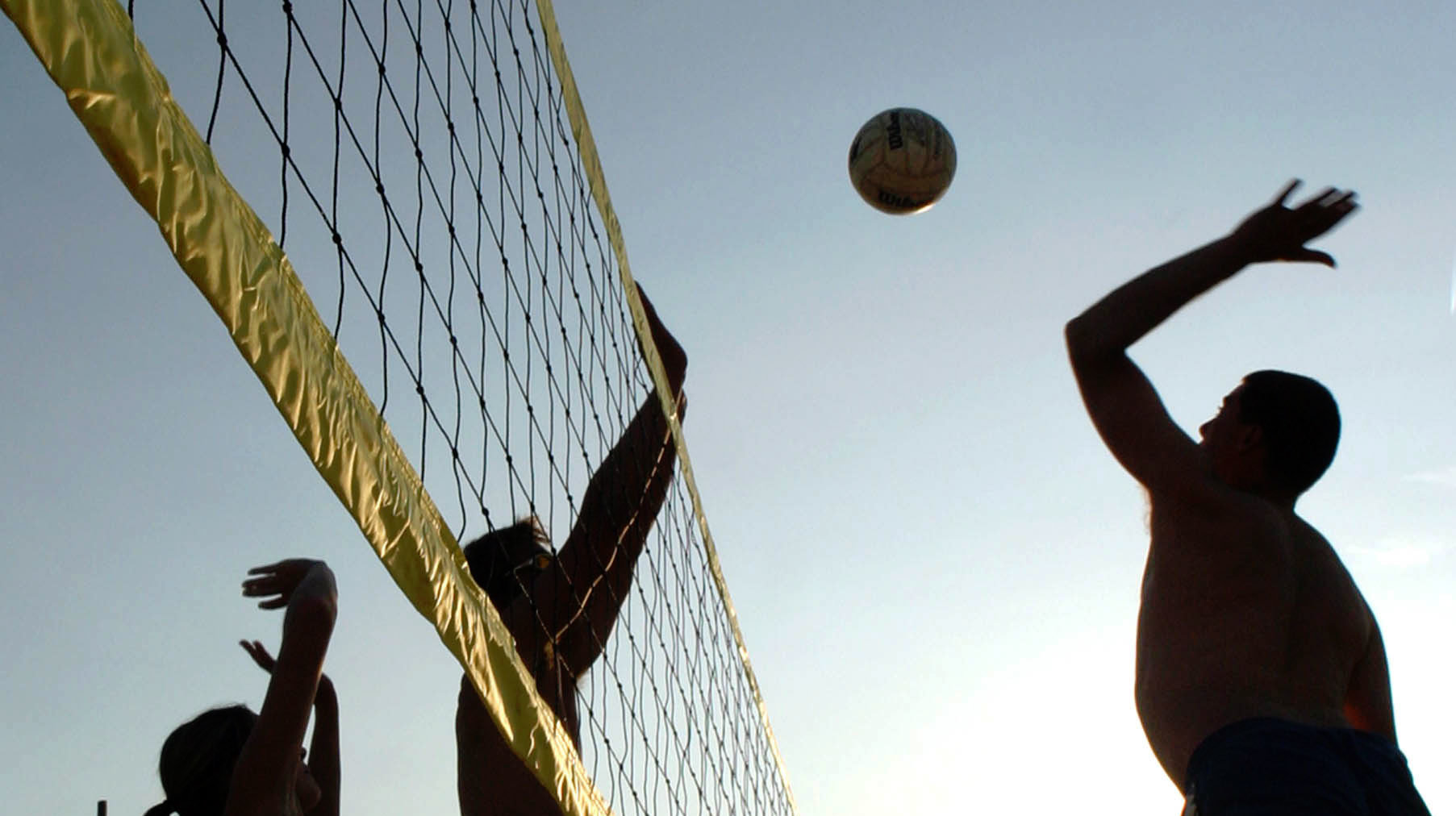The Difference Between Beach and Indoor Volleyball

A lot of people usually prefer to play the game of volleyball in summer. In fact, there are two main types of volleyball – beach volleyball and indoor volleyball. Beach volleyball and indoor volleyball is played by women and men.
It is worth saying that beach and indoor volleyball have a lot of common things. However, there are a lot of differences as well. Today, we are going to talk about the major differences between beach and indoor volleyball. After getting familiar with the main differences between beach and indoor volleyball you will be able to decide what sport suits you better.
Differences in the Sizes of a Playing Court
As it is known, both beach and indoor volleyball are played on the court. Two teams are divided by the net on the court in beach and indoor volleyball. Nevertheless, the playing courts have different sizes.
The playing court of beach volleyball has the following sizes – 16 * 8 meters. The playing court is surrounded by free zone in beach volleyball. The width of free zone is 3 meters on all sides. The playing court of indoor volleyball has the following sizes – 18 * 9 meters. The playing court is surrounded by free zone in indoor volleyball. The width of free zone is 3 meters on all sides.
According to FIVB rules, the free zone of playing court for World and Official competitions in the sport of beach volleyball has to be between 5 and 6 meters from the end lines/side lines. However, the free zone of playing court for World and Official competitions in the sport of indoor volleyball has to be between 5 and 6.5 meters. The height of free playing spot has to be 12.5 meters both in beach and indoor volleyball.
Differences in the Playing Surface
It is important to say that beach and indoor volleyball has different playing surfaces. In beach volleyball, the playing surface is leveled by sand. The height of sand in the playing surface has to be at least 40 centimeters. The sand has to be composed of fine loosely compacted grains.
In indoor volleyball, the game is played on flat and horizontal surface. The surface of the playing court must have a light color. White colors are used to draw the lines on the playing surface in the sport of indoor volleyball. The playing court and the free zone of an indoor court must have different colors. According to the FIVB rules, only either wooden or synthetic surface can be selected for World and Official competitions.
In both cases, the playing surface doesn’t have to pose any risks of cuts or injuries to the players. The playing surface is carefully examined by FIVB representatives before the game. The matches can be played only on FIVB approved playing surfaces.
The Impact of Weather on the Game
Obviously, weather doesn’t have any influence on the game of indoor volleyball. The game of indoor volleyball is allowed if the temperature is between 16° C (61° F) and 25° C (77° F). However, weather is important for the game of beach volleyball. The game of beach volleyball can be played only if weather is fine, presents no risks of injury to the players and can’t have an impact on the results of the match.
Differences in the Net
The net of the same height is used in beach and indoor volleyball. The net’s height is 2.43 meters for men and 2.24 meters for women. Special attention should be drawn to the fact that the height of net can be different in the game of beach volleyball. It depends on the age group of players. For example, the height of net is 2.24 meters for players who are 16 years old or younger. The height of net is 2.12 meters for players who are 14 years old or younger. The height of net is 2.00 meters for players who are 12 years old or younger.
Differences in the Ball
The balls which are used both for beach and indoor volleyball have many differences as well. Comparing to the ball that is used in the game of indoor volleyball, beach volleyball ball is softer and has bigger sizes. However, the weight of both balls is almost the same. It is also necessary to point out that the balls used in indoor and beach volleyball have different parameters.
In the beach volleyball the ball has the following parameters: circumference is between 66 and 68 centimeters, weight is between 260 and 280 grams and inside pressure is between 0.175 to 0.225 kg/cm2.
In the indoor volleyball the ball has the following parameters: circumference is between 65 and 67 centimeters, weight is between 260 and 280 grams and inside pressure is between 0.30 to 0.325 kg/cm2.
Three-ball system is used in beach volleyball and five-ball system is used in indoor volleyball.
It is essential to know that only FIVB approved balls can be used for play in the World and Official competitions both in beach volleyball and indoor volleyball.
Differences in Team Composition
In beach volleyball, the team consists of two players only. Two players participate in the game of beach volleyball. In indoor volleyball, the team consists of up to 12 players. Six players participate in the game of indoor volleyball. In addition, the team of indoor volleyball includes a coach, two assistant coaches, team therapist and a medical doctor. Teams have a team captain both in beach and indoor volleyball.
Differences in Scoring Systems
Beach volleyball and indoor volleyball have different scoring systems. In beach volleyball, a team has to get 21 points and have a minimum lead of 2 points to win a set. If a 20-20 tie is fixed the game has to be continued until a minimum lead of 2 points is achieved by one of teams. If a team wins 2 sets it will win the game. If a team wins one set and loses one set, the 3-rd (or deciding) set will be played. In order to win the 3-rd (or deciding) set a team has to get 15 points and have a minimum lead of 2 points.
However, the rules are different in indoor volleyball. A team has to get 25 points and have a minimum lead of 2 points in order to win a set. If a 24-24 tie is fixed the game has to be continued until a minimum lead of 2 points is achieved by one of teams. If a team wins 3 sets it will win the game. Nevertheless, if a team wins 2 sets and loses 2 sets the 5-th (or deciding) set has to be played. In order to win the 5-th (or deciding) set a team has to get 15 points and have a minimum lead of 2 points.
Differences in Official Warm-Up Session
In beach volleyball the teams are provided with official warm-up period at the net prior the start of the match. If the teams have already had another playing court at their disposal then an official warm-up period will take 3 minutes. However, if the teams haven’t had another playing court at their disposal then an official warm-up period will take 5 minutes.
In indoor volleyball the teams are provided with official warm-up period at the net prior the start of the match. If the teams have already had another playing court at their disposal then an official warm-up period will take 6 minutes. However, if the teams haven’t had another playing court at their disposal then an official warm-up period will take 10 minutes.
Differences in Time-outs, Technical Time-outs, Interruptions and Substitutions
In beach volleyball, a team can request only 1 time-out during the set. A team captain of the game can also request regular game interruption during the match. The special hand signal is used to request time-out during the game of beach volleyball. Time-out can be requested only when the ball is out of play. Requested time-out takes no more than 30 seconds. When the total sum of points scored by two teams is equal to 21 points during set 1 and set 2, a 30-second technical time-out is applied automatically. No technical time-outs are allowed during the 3-rd deciding set in the game of beach volleyball. So, each team can request only one time-out during the 3-rd deciding set.
In indoor volleyball, a team can request only 2 time-outs and 6 substitutions during the set. Substitution is not allowed before the beginning of the set. The special hand signal is used to request time-out during the game of indoor volleyball. Requested time-out takes no more than 30 seconds. When the leading team gets the 8-th and 16-th points during set 1 and 4, two 60-second time-outs are applied automatically. No technical time-outs are allowed during the 5-th deciding set in the game of indoor volleyball. During the 5-th deciding set each of teams can request only two time-outs. Technical timeout can last 30 seconds only.
Check PAKMEN’s High Performance Volleyball programs |
Check PAKMEN’s Beach Volleyball programs |
